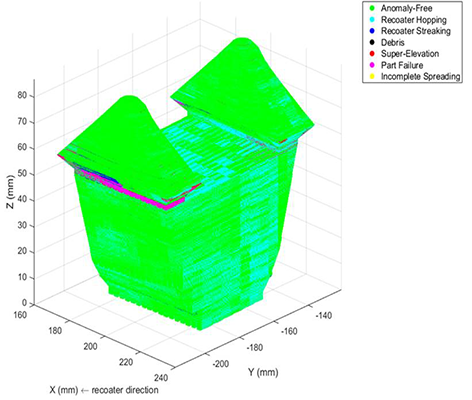Looking through the eyes of a 3-D printer
Luke Scime uses machine vision to optimize the metal 3-D printing process.
Chances are you’ve played with Lego® bricks at some point in your life. Aside from being fun toys, they can also inspire innovation and hands-on building. This is true for Luke Scime, who got his start in engineering by building robots out of Lego® bricks in a middle school program called FIRST®, a robotics nonprofit founded to inspire more young people to become interested in and participate in science and technology. Now a Ph.D. student in mechanical engineering, Scime is working at the intersection of mechanical engineering and computer science to monitor the process of metal 3-D printing.
3-D printing, also known as additive manufacturing, has taken the world by storm with its innovative layer-by-layer manufacturing process used to print three-dimensional objects out of metal, plastic, and other materials. Metal additive manufacturing can offer a robust alternative to traditional manufacturing. The technology has the potential to make stronger, lighter, and more customized products. However, researchers, like Scime, are working to better understand and optimize the printing process.
The metal 3-D printing process that Scime works with, called metal laser powder bed fusion, has only a few steps: the machine spreads a layer of metal powder that’s a fraction of a millimeter thick. Next, a laser beam melts the metal powder into a cross-section of the part that it is building. The machine repeats this process (spreading a layer, then melting it) until the whole part is built.
But, as you spread each layer, issues can occur. For example, the recoater blade used to spread the powder can actually impact and damage the parts. That’s why Scime has initiated a research project to perfect the process.
As I’ve pursued mechanical engineering I somehow always find myself incorporating computer science concepts into traditional engineering.
Luke Scime, Ph.D. candidate, Mechanical Engineering, Carnegie Mellon University
“I'm analyzing how problems occur when you spread each layer,” said Scime. “So the machine takes an image of a layer, and then I use machine-learning techniques to teach the computer to identify flaws.”
Scime analyzes where problems occur by taking images as the machine spreads each layer, using what’s called “machine vision” to collect images of the printing process. He then uses machine learning techniques to teach the computer to recognize what flaws look like. Then, the computer aggregates those images and begins to mark areas where a problem may be occurring.
Though small, these flaws take a number of forms. “Recoater hopping” occurs when the recoater blade lightly impacts the part and “recoater streaking” happens when the blade itself is nicked or damaged. There could also be debris lying on the powder bed that gets in the way as the powder is spread. Parts may also start to warp or deform due to a buildup of residual thermal stresses, called “super-elevation.” Part damage could be significant due to the recoater blade or the spreading could be incomplete when the machine does not spread enough powder for a layer.
While right now Scime focuses on identifying problems, the end goal is for the machine to recognize an issue, then correct it right away, thus perfecting the printing process.
“In the future, the system will be able to detect a problem, then mitigate it so that the problem doesn’t propagate or get worse,” said Scime. “If you know where the problem is happening in real time, you can see the area flagged on the images and be able to either fix it or at least stop it, so you’re not wasting time and material.”
Scime works in Professor of Mechanical Engineering Jack Beuth’s lab. Beuth is also co-director of the NextManufacturing Center. Beuth’s lab focuses on expanding process space—in other words, modifying how much power and speed to give the laser beam and identifying what effects those changing parameters have on a part. In addition to working on expanding process space, Scime also had the desire to incorporate computer science principles—namely machine learning—into solving the problems of the additive manufacturing process. When he came up with the idea to use machine vision in process monitoring, he took a computer science course on computer vision to gain the skills needed to get started.
“Computer science offers opportunities to solve problems that we’re finding in our work with additive manufacturing, problems that we don’t otherwise have a way to solve,” said Scime. “At every stage of my life, as I’ve pursued mechanical engineering I somehow always find myself incorporating computer science concepts into traditional engineering.”
After getting his start with robotics in middle school, Scime attended the University of Florida for mechanical engineering. Scime then came to Carnegie Mellon, where he received his master’s degree in mechanical engineering and is now pursuing his Ph.D.
Scime’s work is pivotal in the field of additive manufacturing. At a time when large companies are more commonly adopting metal additive manufacturing processes to manufacture their parts, Scime’s machine vision techniques pose a solution to help identify issues underlying the process. When researchers are able to resolve these small flaws, then the parts produced with metal additive manufacturing can be used in applications such as airplanes, because these parts are lighter and can be cheaper than parts manufactured using traditional machining processes.
So, when aviation manufacturers more fully adopt additive-produced parts and bring savings to your plane ticket, you can thank Scime and other engineers who are working at the intersection of manufacturing, mechanical engineering, and computer science.



